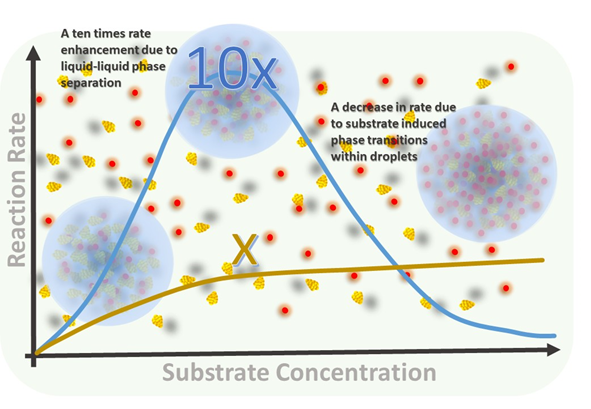Researchers have developed catalytic droplets that can lead to a 10-fold increase in speed and efficient catalytic reactions and that this is valid below a critical substrate concentration. Such efficient chemical reactions can accelerate drug development, leading to quicker access to innovative medications and potentially lower healthcare costs.
Traditionally, chemists have relied on physical and chemical barriers to confine molecules during catalytic reactions. These methods, while effective, come with inherent limitations. The barriers that keep molecules in place can also restrict the movement of substrates and products, ultimately slowing down the very reactions they are meant to facilitate.
Scientists at Institute of Nano Science and Technology (INST), Mohali, an autonomous institute of Department of Science and Technology explored a way to confine nano-catalyst molecules without impeding their movement. Conducting a bold experiment, Professor Sarmistha Sinha and her team, sought to confine protein–metal nanocomposites within droplets formed through liquid–liquid phase separation.
Unlike traditional methods, this approach allowed for barrier-free confinement, so that the molecules within the droplets could move freely. The droplets themselves were indifferent to the native conformation of the proteins they contained, creating an ideal environment for catalysis. The result was a staggering tenfold increase in the catalytic efficiency of the metal nanocatalysts. This discovery opens up new possibilities for accelerating chemical reactions, making them faster and more efficient than ever before.
In a subsequent study, they explored deeper into the behaviour of these droplets under varying conditions. Probing to understand how the interaction between a catalyst and different concentrations of substrate might impact the droplet phase and the kinetics of the catalytic reaction, they found that as the concentration of the substrate increased, the droplets, once fluid and dynamic, began to undergo an internal phase transition.
The excess substrate induced changes within the droplets, restricting the movement of both the substrate and the products. This, in turn, led to a reduction in the overall reaction rate. This discovery suggests that while liquid–liquid phase separation offers incredible potential for enhancing catalysis, the concentration of substrates within these droplets is a critical factor that must be carefully managed.
The finding published in the journal Nanoscale represents a paradigm shift in approach to chemical reactions. The ability to confine molecules within barrier-free droplets while maintaining—or even amplifying—reaction rates could lead to more efficient industrial processes, from drug manufacturing to energy production. Moreover, the insights gained from understanding phase transitions within these droplets could pave the way for new technologies that harness the power of liquid–liquid phase separation.
Publication link: https://doi.org/10.1039/D4NR01402B
 Fate of Catalytic Droplets
Fate of Catalytic Droplets






























